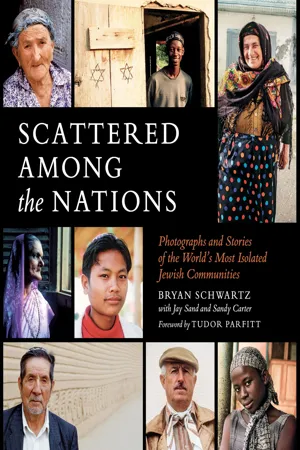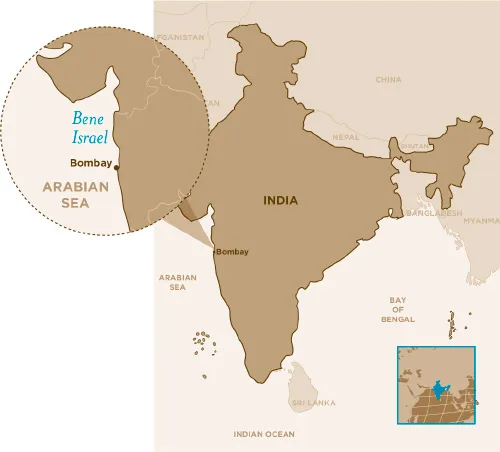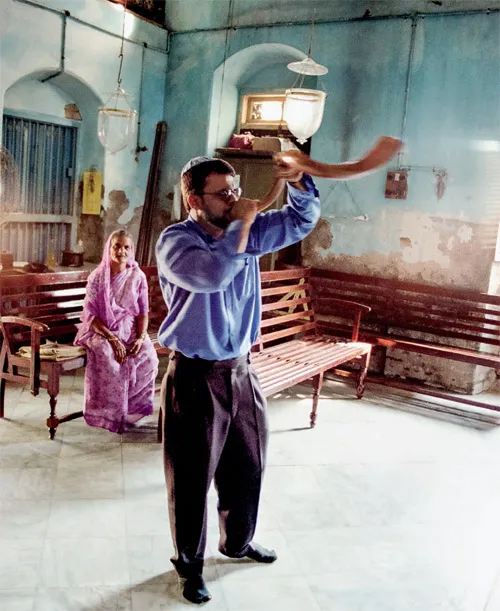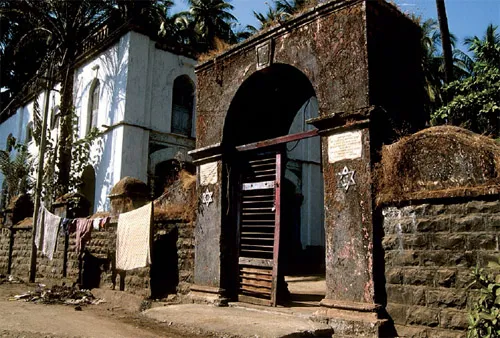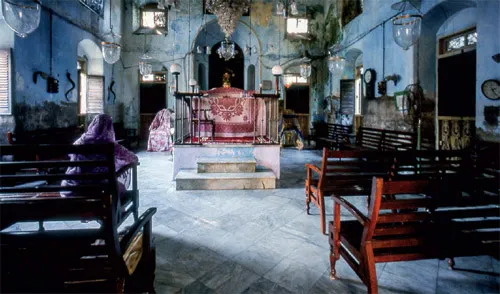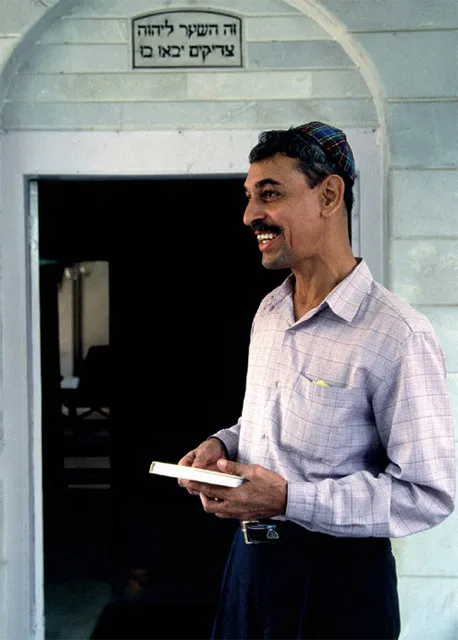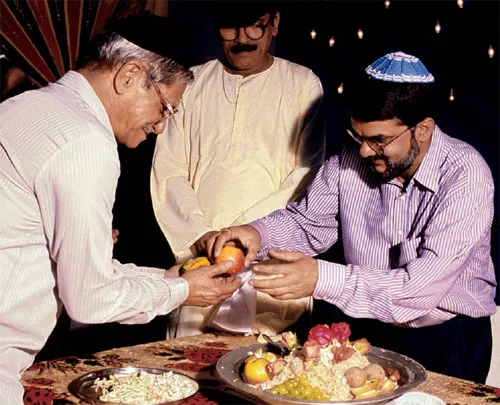![]()
THE LOST TRIBE THAT FOUND ELIJAH
BENE ISRAEL • MAHARASHTRA • INDIA
The Bene Israel (“Children of Israel”) explain that the progenitors of their community were exiled from the Land of Israel more than 2,000 years ago. They shipwrecked off the Konkan Coast in the present-day state of Maharashtra, south of what is Bombay today. Only seven couples made it ashore alive. Twenty centuries later, many Bene Israel remain in India. Despite the Bene Israel’s relatively small numbers across the centuries, they never fully assimilated, even as they adopted Indian dress, the local Marathi language and Maharashtrian surnames. • The community has always remembered its Shema (vow of loyalty to one God), has guarded kosher laws, and has rested on Saturdays. When a Jewish community from Baghdad, Iraq, arrived in India in the late eighteenth century, its members recognized the Bene Israel as coreligionists and helped teach the Indians contemporary Jewish practices. Notwithstanding the Baghdadis’ influence, the Bene Israel maintain what always has been the cornerstone of their unique Jewish-Indian heritage: a special reverence for Elijah the Prophet, who they continue to celebrate in unique rituals and songs. Today, most of the Baghdadis (along with many Bene Israel) have left for Israel, and the former Bene Israel learners have become the leaders of India’s Jewish community.
Above: At Alibag’s Magen Aboth sanctuary, Hazzan Benjamin Dandekar demonstrates the blowing of the shofar, accompanied by Malkah Mordechai Nagavkar, the wife of the synagogue’s shamash, or caretaker. Like the ram’s horn that called ancient Israelites to worship, this shofar is still used on Jewish holidays.
The one hour trip from Bombay to Beth El synagogue is harrowing. Traffic turns three lanes into two, dodging Sikh shepherds leading their goats along the roadside. The driver, straddling the road’s shoulder, honks to an approaching parade of women wearing flip flops and brightly colored sarees. Carrying bundles of logs on their heads that are triple the women’s height, they still manage to quick step and avoid collision. Monkeys scream from trees on the fringes of the road. Passing a smog billowing truck on a blind curve, the car lurches headlong toward an oncoming bus. “Holy...!”
Benjamin Simon Joseph Dandekar leans back in the passenger seat laughing. “Don’t worry,” he reassures the non-Indians sitting behind him, clinging white-knuckled to the car doors and each other, “the hazzan is with you!”
The middle-aged Dandekar (who goes by Benny) has served as the hazzan, or Jewish prayer leader, of Bene Israel (“Children of Israel”) communities in and around Bombay for over 25 years. “I am the chosen man of the chosen people of G-d, chosen to be a community leader in India,” Benny explains. “G-d is very near to me.”
Whether or not Benny’s “Chosenness” will protect him on India’s roads, it has made him a celebrity among the approximately 5,000 Jews who live in Bombay and the surrounding towns and villages of India’s Maharashtra Province. “I am famous because I am a good teacher,” the dapper Benny boasts. Then he adds more humbly, as he adjusts his glasses and strokes his grey black moustache and beard, “I feel satisfied when I am doing my prayers and teaching them to others.”
Above: Though the Magen Aboth synagogue in Alibag, in the Maharashtra state, dates from 1848, some say that for 800 years the Bene Israel have uttered Jewish prayers in this village, three hours south of Bombay. Community members still pray daily here, and on Shabbat collect a minyan from the town’s eight to ten remaining Jewish families.
Most of those who Hazzan Dandekar teaches are fellow Bene Israel members, but Benny also instructs international Jewish tourists in the unique history of the Bene Israel. Now, over the cacophony of blaring horns and the driver’s radio, Benny recounts Bene Israel legends to the passengers, whose bare legs stick to the back seat as they sweat uncomfortably in the stifling humidity that perpetually afflicts western central India.
The progenitors of the modern community were exiled from the Land of Israel hundreds of years before the Common Era, Benny says. They shipwrecked off the palm-bedecked Konkan Coast, south of what is now Bombay. Only seven couples made it ashore alive. Visitors may still see the Jewish cemetery in the village of Navagaon where these survivors buried the bodies they were able to salvage.
Above: Inside Alibag’s Magen Aboth synagogue.
Thousands of years later, many Bene Israel remain in India—though they constitute a tiny fraction of India’s teeming population. Despite the Bene Israel’s relatively small numbers, across the centuries, they never fully assimilated, even as they adopted Indian dress, the local Marathi language and Maharashtrian surnames—like Dandekar. The community always remembered the Shema, guarded kosher laws, and rested on Saturdays.
“I am the chosen man of the chosen people of G-d, chosen to be a community leader in India. G-d is very near to me.”
BENJAMIN SIMON JOSEPH DANDEKAR
Benny momentarily pauses in his story when the driver slams on the brakes to avoid exploding into a mule-drawn manure cart hogging two lanes. Unfazed, the hazzan resumes. He relates that when Jewish traders from Baghdad arrived in India in the late eighteenth century, they recognized the Bene Israel as coreligionists. The Baghdadis constructed grandiose new synagogues and Jewish schools. Though tensions sometimes existed between the wealthier Baghdadi arrivals and the poorer Bene Israel, the Iraqis helped teach the Indians contemporary Jewish practices.
After the modern State of Israel’s establishment in 1948, nearly all of the Baghdadi Jews (and many Bene Israel) made Aliyah from India to Israel. The Baghdadis’ positions throughout the community have been largely assumed by the remaining Bene Israel. The former Bene Israel learners, like Benny, are now the instructors.
Above: A Bene Israel boy stands in the doorway of Magen Hassidim synagogue.
Notwithstanding the Baghdadis’ influence, the Bene Israel maintained what was the cornerstone of their unique, Jewish-Indian heritage: a special reverence for Elijah the Prophet (Eliahu Ha’Navi). Every Saturday night, dozens of Bene Israel from around Maharashtra Province honor Elijah by bringing food and flowers to the more than 160-year-old Beth El synagogue in the town of Panvel.
The passengers are relieved when they finally arrive at Beth El, located on Mahatma Gandhi Road. Gratefully entering the safety of Beth El’s compound, they resist the temptation to kiss the ground. The visitors unload their pocket change for the women in flowing fluorescent pink and green fabrics who beg around the synagogue’s outer wall.
Above: Yehoshua Yehuda Pinglekar, the hazzan in Panvel, stands after his weekday morning prayers at the Beth El synagogue.
From the bimah (platform) at the center of Beth El’s shadowy sanctuary, Yehoshua Yehuda Pinglekar radiates peace—the only thing the new arrivals crave more than air conditioning. Yehoshua, the leader of the Panvel Jewish community, which normally includes only six families, stands with his head deep in his prayer shawl. Benny removes his shoes and softly pads into the chamber. Oblivious to Benny’s entrance, Yehoshua sways, reverently reciting the words of the morning Shacharit service, standing barefoot on a beaded wooden mat. Yehoshua later explains that the mat keeps him alert during long hours of meditative, daily worship.
Concluding the ritual, Yehoshua greets his friend Benny warmly and slips into sandals decorated with Hindu swastikas, considered good luck symbols locally. “What is your good name?” Yehoshua inquires, welcoming each unfamiliar visitor, insisting that everyone joins him for a traditional, steaming glass of chai (tea), spiced with ginger and cardamom and brimming with curdled milk.
Above: Before a Bene Israel wedding, Benjamin Simon Joseph Dandekar (right) leads a malida ceremony, with help from the bride’s father (center) and uncle (left). The Bene Israel sing songs and offer a mixture of five fruits, flowers, spices, shredded coconut, rice, and local grains to Elijah.
Blowing on his chai, Yehoshua elaborates on the weekly ceremony in Panvel honoring Elijah. “The Bene Israel,” he says, “have experienced Eliahu Ha’Navi coming to them. Our forefathers had living encounters with him in human form. Eliahu is the only person ...
